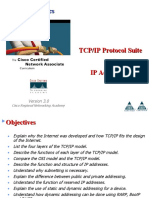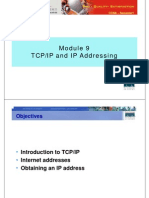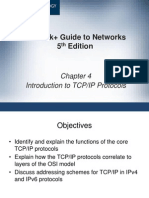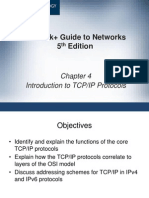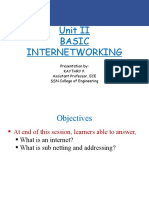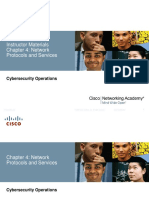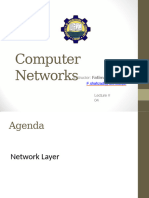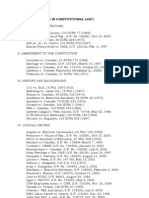100%(1)100% found this document useful (1 vote)
38 viewsWeek 2 IP Addressing Overview
IP addressing consists of four bytes divided into a network address and host address. There are three classes - Class A uses the first byte for network addressing and supports over 16 million hosts, Class B divides the first two bytes evenly between network and host, and Class C uses the first three bytes for network addressing and supports up to 254 hosts. IPv6 expanded the address space to 16 bytes or 128 bits to accommodate more devices.
Uploaded by
Aziz LondonCopyright
© © All Rights Reserved
Available Formats
Download as PDF, TXT or read online on Scribd
100%(1)100% found this document useful (1 vote)
38 viewsWeek 2 IP Addressing Overview
IP addressing consists of four bytes divided into a network address and host address. There are three classes - Class A uses the first byte for network addressing and supports over 16 million hosts, Class B divides the first two bytes evenly between network and host, and Class C uses the first three bytes for network addressing and supports up to 254 hosts. IPv6 expanded the address space to 16 bytes or 128 bits to accommodate more devices.
Uploaded by
Aziz LondonCopyright
© © All Rights Reserved
Available Formats
Download as PDF, TXT or read online on Scribd
You are on page 1/ 9
IP Addressing
Consists of four bytes
Divided into two components
Network address
Host address
Classes
Class A
Class B
Class C
Hands-On Ethical Hacking and Network Defense, Second Edition 1
Hands-On Ethical Hacking and Network Defense, Second Edition 2
Table 2-3 TCP/IP address classes
IP Addressing (contd.)
Class A
First byte is reserved for network address
Last three bytes are available for host computers
Supports more than 16 million host computers
Limited number of Class A networks
Reserved for large corporations and governments
Format: network.node.node.node
Hands-On Ethical Hacking and Network Defense, Second Edition 3
IP Addressing (contd.)
Class B
Divided evenly
Two-octet network address
Two-octet host address
Supports more than 65,000 hosts
Assigned to large corporations and Internet Service
Providers (ISPs)
Format: network.network.node.node
Hands-On Ethical Hacking and Network Defense, Second Edition 4
IP Addressing (contd.)
Class C
Three-octet network address and one-octet host
address
More than two million Class C addresses
Supports up to 254 host computers
Usually available for small business and home use
Format: network.network.network.node
Hands-On Ethical Hacking and Network Defense, Second Edition 5
IP Addressing (contd.)
Subnet mask
Each network must be assigned a subnet mask
Helps distinguish network from host address bits
Subnetting concepts are important
Utilities return information based on IP address and
subnet information
May be useful when penetration testing
Hands-On Ethical Hacking and Network Defense, Second Edition 6
Planning IP Address Assignments
Each network segment must have a unique
network address
Address cannot contain all 0s or all 1s
Accessing entities and services on other networks
Each computer needs IP address of gateway
TCP/IP Internet layer uses subnet mask to
determine destination computers network address
If addresses are different, relays packet to gateway
Gateway forwards packet to its next destination
Packet eventually reaches destination
Hands-On Ethical Hacking and Network Defense, Second Edition 7
IPv6 Addressing
Internet Protocol version 6 (IPv6)
Wasnt designed with security in mind
Many current network vulnerabilities
Developed to increase IP address space and
provide additional security
Uses 16 bytes, or a 128-bit address
2
128
available addresses
Many OSs are configured to enable IPv6
Many router filtering devices, firewalls, and intrusion
detection systems are not
Hackers bypass security systems
Hands-On Ethical Hacking and Network Defense, Second Edition 8
Summary
IP addressing
Four bytes and three classes (A, B, and C)
IPv6 addresses
16 bytes
Written in hexadecimal notation
Hands-On Ethical Hacking and Network Defense, Second Edition 9
You might also like
- Retreats Ora Grodsky and Jeremy PhillipsNo ratings yetRetreats Ora Grodsky and Jeremy Phillips11 pages
- Hands-On Ethical Hacking and Network Defense, 3rd Edition: TCP/IP Concepts ReviewNo ratings yetHands-On Ethical Hacking and Network Defense, 3rd Edition: TCP/IP Concepts Review41 pages
- Chapter Objectives:: Understand The "Big Picture"No ratings yetChapter Objectives:: Understand The "Big Picture"21 pages
- Network+ Guide To Networks 5 Edition: In-Depth TCP/IP NetworkingNo ratings yetNetwork+ Guide To Networks 5 Edition: In-Depth TCP/IP Networking63 pages
- How The TCP/IP Protocol Works: Les Cottrell - SLACNo ratings yetHow The TCP/IP Protocol Works: Les Cottrell - SLAC49 pages
- Network+ Guide To Networks 5 Edition: Introduction To TCP/IP ProtocolsNo ratings yetNetwork+ Guide To Networks 5 Edition: Introduction To TCP/IP Protocols88 pages
- Network+ Guide To Networks 6 Edition: Introduction To TCP/IP ProtocolsNo ratings yetNetwork+ Guide To Networks 6 Edition: Introduction To TCP/IP Protocols68 pages
- 4.1 - History of TCP/IP 4.2 - IP Addressing 4.3 - Name Resolution 4.4 - TCP/IP ProtocolsNo ratings yet4.1 - History of TCP/IP 4.2 - IP Addressing 4.3 - Name Resolution 4.4 - TCP/IP Protocols50 pages
- Support - Ethernet Et Accès Multiples (Séance 6)No ratings yetSupport - Ethernet Et Accès Multiples (Séance 6)24 pages
- Unit II Basic Internetworking: Presentation By: Kaythry P. Assistant Professor, ECE SSN College of EngineeringNo ratings yetUnit II Basic Internetworking: Presentation By: Kaythry P. Assistant Professor, ECE SSN College of Engineering63 pages
- Network+ Guide To Networks 6 Edition: Introduction To TCP/IP ProtocolsNo ratings yetNetwork+ Guide To Networks 6 Edition: Introduction To TCP/IP Protocols133 pages
- Instructor Materials Chapter 4: Network Protocols and ServicesNo ratings yetInstructor Materials Chapter 4: Network Protocols and Services43 pages
- Addressing: The What' and Where' of CommunicationNo ratings yetAddressing: The What' and Where' of Communication58 pages
- Chapter 3- Network Layer and Ip_addressing_and_subnettingNo ratings yetChapter 3- Network Layer and Ip_addressing_and_subnetting61 pages
- UCCN1004 - Lect2a - Intro To Network Devices - AddressingNo ratings yetUCCN1004 - Lect2a - Intro To Network Devices - Addressing28 pages
- Support - TCP Et Routage IP (Séance 6) (1)No ratings yetSupport - TCP Et Routage IP (Séance 6) (1)140 pages
- Computer Networking: An introductory guide for complete beginners: Computer Networking, #1From EverandComputer Networking: An introductory guide for complete beginners: Computer Networking, #14.5/5 (2)
- En Security Chp6 PTActB L2-VLAN-Security StudentNo ratings yetEn Security Chp6 PTActB L2-VLAN-Security Student3 pages
- Answer CCNA Security Chapter 5 Test - CCNAS v1.1 - Invisible AlgorithmNo ratings yetAnswer CCNA Security Chapter 5 Test - CCNAS v1.1 - Invisible Algorithm11 pages
- CCNAS - Chp2 - PTActA - Syslog-SSH-NTP - InstructorNo ratings yetCCNAS - Chp2 - PTActA - Syslog-SSH-NTP - Instructor5 pages
- 12-03-12 94421-StorageAreaNetworks TM PDFNo ratings yet12-03-12 94421-StorageAreaNetworks TM PDF0 pages
- 12-03-12 63755-De Dev Out IEEE-802-11 BR WNet SS NS PDFNo ratings yet12-03-12 63755-De Dev Out IEEE-802-11 BR WNet SS NS PDF0 pages
- A&Q - Final Exam - Fundamentals of Wireless LANs (Version 1.2)0% (1)A&Q - Final Exam - Fundamentals of Wireless LANs (Version 1.2)14 pages
- Exploration Routing: OSPF Skills Based Assessment100% (2)Exploration Routing: OSPF Skills Based Assessment4 pages
- Jose Daniel G. Asuncion: 2FB Dapitan Regency Dapitan St. Sampaloc, Manila 20:00No ratings yetJose Daniel G. Asuncion: 2FB Dapitan Regency Dapitan St. Sampaloc, Manila 20:003 pages
- Letter From Department of State General Counsel Brad McvayNo ratings yetLetter From Department of State General Counsel Brad Mcvay2 pages
- Taipei Trash & Recycling: A Short Guide - COLLECTIVE GREENNo ratings yetTaipei Trash & Recycling: A Short Guide - COLLECTIVE GREEN11 pages
- WWW Who Int/workforcealliance/knowledge/toolkit/33 PDFNo ratings yetWWW Who Int/workforcealliance/knowledge/toolkit/33 PDF1 page
- Mechanic (HT, LT Equipments and Cable Jointing)No ratings yetMechanic (HT, LT Equipments and Cable Jointing)43 pages
- Byte Con Fiden Tial Don Otc Opy: Model Name: Ga-H110M-S2HNo ratings yetByte Con Fiden Tial Don Otc Opy: Model Name: Ga-H110M-S2H50 pages
- New Mexico v. Wilson, No. S-1-SC-38510 (N.M. June 7, 2021)No ratings yetNew Mexico v. Wilson, No. S-1-SC-38510 (N.M. June 7, 2021)55 pages
- The Beginners Guide To Nintendo DS HomebrewNo ratings yetThe Beginners Guide To Nintendo DS Homebrew26 pages
- Practical Obstetrics and Gynaecology Handbook for O G Clinicians and General Practitioners 2nd Edition Thiam Chye Tan - Read the ebook online or download it to own the full contentNo ratings yetPractical Obstetrics and Gynaecology Handbook for O G Clinicians and General Practitioners 2nd Edition Thiam Chye Tan - Read the ebook online or download it to own the full content76 pages
- Free Access to Test Bank for Guide to Firewalls and VPNs, 3rd Edition Chapter Answers100% (6)Free Access to Test Bank for Guide to Firewalls and VPNs, 3rd Edition Chapter Answers30 pages
- TB2-SDC - VPM210171-00100-M-M1B-PFD-0001 Rev0No ratings yetTB2-SDC - VPM210171-00100-M-M1B-PFD-0001 Rev023 pages
- BAKAR INUWA COMPLETE HAUSA NOVEL - Ganya Hub - Page 2No ratings yetBAKAR INUWA COMPLETE HAUSA NOVEL - Ganya Hub - Page 216 pages
- Hands-On Ethical Hacking and Network Defense, 3rd Edition: TCP/IP Concepts ReviewHands-On Ethical Hacking and Network Defense, 3rd Edition: TCP/IP Concepts Review
- Network+ Guide To Networks 5 Edition: In-Depth TCP/IP NetworkingNetwork+ Guide To Networks 5 Edition: In-Depth TCP/IP Networking
- How The TCP/IP Protocol Works: Les Cottrell - SLACHow The TCP/IP Protocol Works: Les Cottrell - SLAC
- Network+ Guide To Networks 5 Edition: Introduction To TCP/IP ProtocolsNetwork+ Guide To Networks 5 Edition: Introduction To TCP/IP Protocols
- Network+ Guide To Networks 6 Edition: Introduction To TCP/IP ProtocolsNetwork+ Guide To Networks 6 Edition: Introduction To TCP/IP Protocols
- 4.1 - History of TCP/IP 4.2 - IP Addressing 4.3 - Name Resolution 4.4 - TCP/IP Protocols4.1 - History of TCP/IP 4.2 - IP Addressing 4.3 - Name Resolution 4.4 - TCP/IP Protocols
- Unit II Basic Internetworking: Presentation By: Kaythry P. Assistant Professor, ECE SSN College of EngineeringUnit II Basic Internetworking: Presentation By: Kaythry P. Assistant Professor, ECE SSN College of Engineering
- Network+ Guide To Networks 6 Edition: Introduction To TCP/IP ProtocolsNetwork+ Guide To Networks 6 Edition: Introduction To TCP/IP Protocols
- Instructor Materials Chapter 4: Network Protocols and ServicesInstructor Materials Chapter 4: Network Protocols and Services
- Chapter 3- Network Layer and Ip_addressing_and_subnettingChapter 3- Network Layer and Ip_addressing_and_subnetting
- UCCN1004 - Lect2a - Intro To Network Devices - AddressingUCCN1004 - Lect2a - Intro To Network Devices - Addressing
- Computer Networking: An introductory guide for complete beginners: Computer Networking, #1From EverandComputer Networking: An introductory guide for complete beginners: Computer Networking, #1
- Answer CCNA Security Chapter 5 Test - CCNAS v1.1 - Invisible AlgorithmAnswer CCNA Security Chapter 5 Test - CCNAS v1.1 - Invisible Algorithm
- CCNAS - Chp2 - PTActA - Syslog-SSH-NTP - InstructorCCNAS - Chp2 - PTActA - Syslog-SSH-NTP - Instructor
- 12-03-12 63755-De Dev Out IEEE-802-11 BR WNet SS NS PDF12-03-12 63755-De Dev Out IEEE-802-11 BR WNet SS NS PDF
- A&Q - Final Exam - Fundamentals of Wireless LANs (Version 1.2)A&Q - Final Exam - Fundamentals of Wireless LANs (Version 1.2)
- Jose Daniel G. Asuncion: 2FB Dapitan Regency Dapitan St. Sampaloc, Manila 20:00Jose Daniel G. Asuncion: 2FB Dapitan Regency Dapitan St. Sampaloc, Manila 20:00
- Letter From Department of State General Counsel Brad McvayLetter From Department of State General Counsel Brad Mcvay
- Taipei Trash & Recycling: A Short Guide - COLLECTIVE GREENTaipei Trash & Recycling: A Short Guide - COLLECTIVE GREEN
- WWW Who Int/workforcealliance/knowledge/toolkit/33 PDFWWW Who Int/workforcealliance/knowledge/toolkit/33 PDF
- Byte Con Fiden Tial Don Otc Opy: Model Name: Ga-H110M-S2HByte Con Fiden Tial Don Otc Opy: Model Name: Ga-H110M-S2H
- New Mexico v. Wilson, No. S-1-SC-38510 (N.M. June 7, 2021)New Mexico v. Wilson, No. S-1-SC-38510 (N.M. June 7, 2021)
- Practical Obstetrics and Gynaecology Handbook for O G Clinicians and General Practitioners 2nd Edition Thiam Chye Tan - Read the ebook online or download it to own the full contentPractical Obstetrics and Gynaecology Handbook for O G Clinicians and General Practitioners 2nd Edition Thiam Chye Tan - Read the ebook online or download it to own the full content
- Free Access to Test Bank for Guide to Firewalls and VPNs, 3rd Edition Chapter AnswersFree Access to Test Bank for Guide to Firewalls and VPNs, 3rd Edition Chapter Answers
- BAKAR INUWA COMPLETE HAUSA NOVEL - Ganya Hub - Page 2BAKAR INUWA COMPLETE HAUSA NOVEL - Ganya Hub - Page 2






